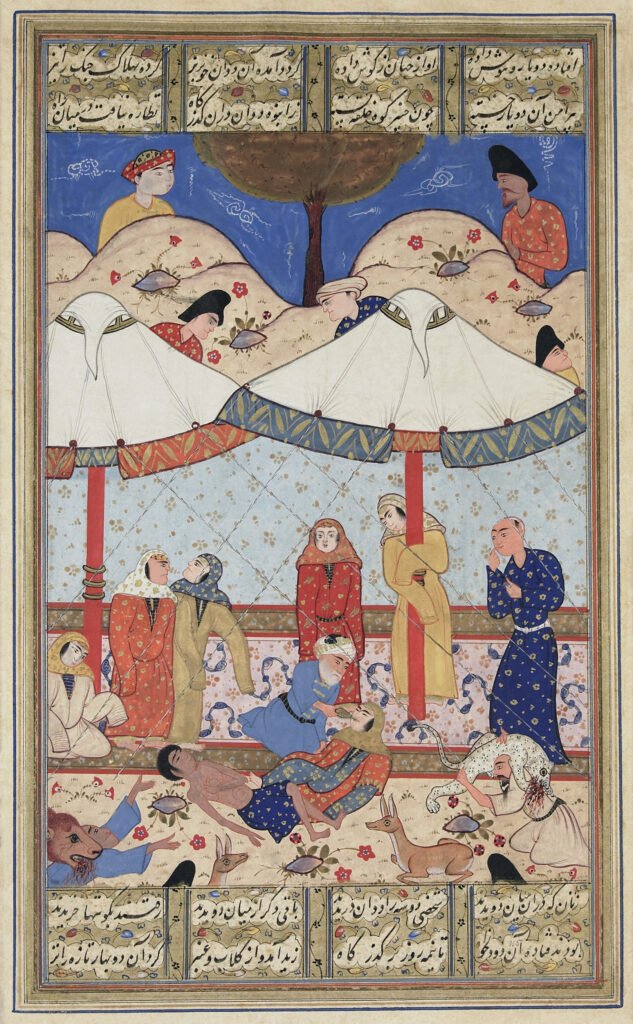The Persian Love Story of Layla and Majnun
The tale of Layla and Majnun is an ancient Persian love story that has captivated audiences for centuries. It tells the tragic tale of Qays, a poet who falls deeply in love with Layla, a beautiful and intelligent young woman. However, their love is plagued by societal expectations and ultimately ends in heartbreak. The story of Layla and Majnun has become a symbol of unrequited love and has had a profound influence on Persian literature and culture.

The Origin and Background of the Tale
The origins of the tale of Layla and Majnun can be traced back to the 7th century in Arabia. It is said to be based on the true story of a poet named Qays ibn al-Mulawwah who fell in love with a woman named Layla bint Mahdi ibn Sa’d. Their love was forbidden, and Qays was eventually driven to madness due to his longing for Layla. Their story was immortalized in the Arabic poet Nizami Ganjavi’s epic poem called “Layla and Majnun.”
Qays and Layla: The Beginnings of Love
Qays and Layla were childhood friends who grew up together in the same tribe. As they matured, their friendship blossomed into love. Qays became infatuated with Layla and expressed his love for her through his poetry. Layla, although aware of Qays’ affections, could not openly reciprocate due to societal constraints. However, their love for each other continued to grow, even in secret.
The Tragic Separation of Qays and Layla
As their love became more evident, Layla’s father began to disapprove of their relationship due to Qays’ reputation as a poet and his lack of social status. Layla’s father decided to marry her off to another man, separating her from Qays. This separation devastated both Qays and Layla, causing them immense pain and longing for each other. Despite their separation, their love persisted.
Qays’ Descent into Madness: The Birth of Majnun
Unable to bear the separation from Layla, Qays retreated from society and became consumed by his love for her. He wandered aimlessly in the desert, neglecting his appearance and sanity. People began to call him Majnun, meaning “possessed by jinn,” as his love for Layla had driven him to madness. Majnun’s only solace was in his poetry, which he used to express his undying love for Layla.
Majnun’s Love for Layla: A Tale of Unrequited Passion
Majnun’s love for Layla continued to grow even though he knew he could never be with her. His love for her became the epitome of unrequited passion, as Layla was bound by societal expectations and her marriage to another man. Despite the impossibility of their union, Layla remained a source of inspiration for Majnun’s poetry, which became renowned for its heartfelt and poignant expressions of love and longing.
The Sorrowful Wanderings of Majnun in the Desert
Majnun’s madness led him to wander aimlessly in the desert, living a solitary life. His disheveled appearance and eccentric behavior made him an outcast among society. Yet, he found solace in the wilderness, where he could freely express his love for Layla. Majnun’s wanderings in the desert became a symbol of his relentless devotion and his inability to find peace without Layla by his side.
Layla’s Unattainable Love: A Test of Majnun’s Devotion
Despite Layla’s unattainable love, her heart remained connected to Majnun. She recognized the depth of his devotion and admired his unwavering love for her. Layla’s love became a test for Majnun’s devotion and a testament to the power of love itself. She remained a symbol of unattainable beauty and love, driving Majnun to continue his sorrowful wanderings in the desert in pursuit of her.
Majnun’s Untimely End: A Heartbreaking Conclusion
The tale of Layla and Majnun concludes with Majnun’s untimely end. In his solitude and madness, Majnun passed away in the desert, still pining for Layla. When Layla learned of his death, her heart broke, and she passed away soon after, unable to bear the loss. Their tragic deaths served as a reminder of the power and intensity of their love, which transcended the boundaries of life itself.
The Influence of Layla and Majnun on Persian Literature
The tale of Layla and Majnun has had a profound influence on Persian literature. It has inspired countless poets, writers, and artists throughout history. The story’s themes of love, longing, and sacrifice have been explored in various Persian literary works, including the famous poem “Khosrow and Shirin” by Nezami Ganjavi. Layla and Majnun’s story continues to captivate and inspire audiences with its timeless portrayal of love and tragedy.
Popular Adaptations and Interpretations of the Love Story
Over the centuries, the tale of Layla and Majnun has been adapted and reimagined in various art forms. It has been depicted in paintings, plays, operas, and even movies. One of the most notable adaptations is the opera “Layla and Majnun” composed by Azerbaijani composer Uzeyir Hajibeyli. These adaptations have allowed the story to reach wider audiences and further cement its status as a timeless tale of love and tragedy.
Layla and Majnun: A Timeless Tale of Love and Tragedy
The story of Layla and Majnun continues to resonate with audiences worldwide. It serves as a reminder of the power of love and the sacrifices that come with it. Their tragic tale has become a symbol of unrequited love and the enduring nature of true devotion. The Persian love story of Layla and Majnun remains an integral part of Persian culture and literature, captivating hearts for centuries to come.
The tale of Layla and Majnun is a testament to the timeless power of love and its ability to transcend societal boundaries. It serves as a reminder that love, even in its most tragic form, can inspire great art and touch the hearts of generations. The story of Layla and Majnun will continue to be cherished and celebrated for its heartfelt portrayal of love and tragedy in Persian literature and beyond.

